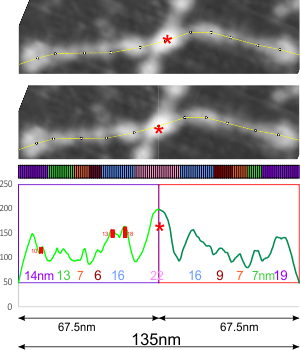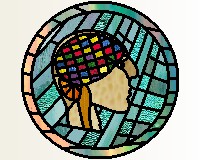Monthly Archives: June 2020
Three variations, same results, 4 peaks
Three variations on the measurement approach, basically provide the same results: there are very likely 4 peaks between the Ntermini junction and the CRD in a dodecamer arm (one-hexamer end to end).
Figure below is the original image (arroyo et al, i think the supplemental figure 4A), converted to grayscale using ‘luminosity’ which in my opinion provides the best contrast and brightness but the algorithms for that process i have not looked up. Using FiJi (Image2 update) I gathered brightness peaks using the LUT table plot menu. The plot arm along each hexamer (CRD to CRD) is shown with a crop of a screen print. The data were saved and plotted in excel. Each hexamer center was found and each arm adjusted to (images and plots alike (red asterisks for original and adjusted – top image is “as is” bottom image is halves equal to 67.5nm — of a whole dodecamer of approximately 135nm). Then using gwyddion i image processes (they call it data processing on their menu) and resulting image i inverted in photoshop and analyzed for peaks along the collagen-like domain using FiJi. In this case that domain has four peaks. There is some question whether the peak just before the CRD could be the coiled coil domain. It is very commonly a cone shaped with the wider part just before the CRD domains would bend and partially hide it. (visualize – the cone part of an ice cream cone). I mention here that there is an angularity to the peaks that actually i have noticed…. i might measure that declination.

Processing the image in gwyddion in my opinion (all kinds of processing applied) really didn’t help define the peaks. No better in my mind than just using photoshop or corelDRAW to adjust the contrast and brightness. Had different data emerged i guess that would have been interesting, but since it did not, this adds credence to the plots obtained in grayscale conversions (with out additional algorithms applied) as being true to the original scans, and containing the same details.
This particular image which i have worked over and over is not really the best nor the worst AMF of a dodecamer, it is pretty run of the mill.
Images below show the vertical and horizontal arms, with LUT plots from the processed image, in duplicate, and each centered, and the nm of each peak is colored as well as given in text.


Old cover submission
Forever in love with SP-D
Ha! I hope you have a sense of humor. I am using a new program, and some nonsensical algorithm produce a black and white image that I was compelled to play games with. Anyone who wants a poster of this famous SP-D molecule (well studied by me but originally published by Arroyo et al, and totally turned into vector-pop-art by me) just ask and pay for printing and shipping, I get nothing, and its yours. Rest assured, no government funds were spent on this colorized image.
Does it matter which algorithm you use to process your images, or should you use your common sense
Does it matter which algorithm you use, or should you use your common sense? Grappling with how to go about determining the number of peaks in collagen-like segment of SP-D just seems to be best done by the person looking at the micrograph. I am trying out a new program, Gwyddion, and it makes really nice pictures, no question, its not that easy to use in my humble opinion, but it seems to have some advantages over using CorelDRAW alonside ImageJ (FIJI) but some annoying disadvantages as well.
(Aside from being more for the person who wants to customize image processing, there is nothing that the “visual” based learning experience can benefit from here, except perhaps from approaching the program with trial and error (pretty much what i did, trying to get some data from the process along the way).
I am struck by the divide in cortical processes between the programmer mind and the microscopist’s mind, and a little incensed at the arrogance when interfaces are (as they claim are intuitive thereby attributing some degree of ineptitude on one who views it otherwise. This, like many other professional venues, select for a specific trait.)
For me, it has not proven useful to use any of the image processing programs (ImageJ, J2, FIJI or Gwyddion, photoshop, CorelDRAW) to confirm or refudiate the presence of peaks along the collagen like domain of SP-D. Hundreds of plots later, i still get a mix of 3 to 4 peaks. In the above, mean number of peaks in that region was 3. There are a few pix i would remove since i actually think there are four peaks. Bias is an easy thing to introduce, but no bias skews the results when applied randomly as in these images. Original image is from Arroyo et al’s paper and also the same image is in supplemental figure 4.
Count, N: 47
Sum, Σx: 144
Mean, μ: 3.06+1.29
Variance, σ2: 1.67
Below… the two images which really dont help resolve the peaks in the collagen-like domain have been excluded. One wonders how to explain bias if I pick the best representations. It is something like what one experiences when doing stereology on a circle, where one rarely finds the optimal diameter, and in this case the optimal peak number, so all values need to be evaluated with this in mind.
Count, N: 41
Sum, Σx: 143
Mean, μ: 3.48+0.85
Variance, σ2: 0.73
How often does optimal “happen” in the preparation of SP-D. Establishing the right number of samples – finding the right (maybe several) approach to measuring.
Not My America, But Our America: part 2
Wikipedia defines the pre-frontal cortex thusly: “This brain region has been implicated in planning complex cognitive behavior, personality expression, decision making, moderating social behavior, and moderating certain aspects of speech and language. The basic activity of this brain region is considered to be orchestration of thoughts and actions in accordance with internal goals. (italics=my question – who -what sets our internal goals?)
The most typical psychological term for functions carried out by the prefrontal cortex area is executive function. Executive function relates to abilities to differentiate among conflicting thoughts, determine good and bad, better and best, same and different, future consequences of current activities, working toward a defined goal, prediction of outcomes, expectation based on actions, and social “control” (the ability to suppress urges that, if not suppressed, could lead to socially unacceptable outcomes). (italics=my opinion. Can we have a successful executor (president) with a non-functional prefrontal cortex)
“This brain region has been implicated in planning complex cognitive behavior, personality expression, decision making, moderating social behavior, and moderating certain aspects of speech and language. The basic activity of this brain region is considered to be orchestration of thoughts and actions in accordance with internal goals.
The most typical psychological term for functions carried out by the prefrontal cortex area is executive function. Executive function relates to abilities to differentiate among conflicting thoughts, determine good and bad, better and best, same and different, future consequences of current activities, working toward a defined goal, prediction of outcomes, expectation based on actions, and social “control” (the ability to suppress urges that, if not suppressed, could lead to socially unacceptable outcomes)”. (my italics) Therein lie the genetic, epigenetic, early environmental influences that govern our ability to be “open” “loving” “accepting” of things that lie around us; our ability to “adapt” “accept” and “change”.
There is no better example of the well functioning executive function guidelines (as parents and society we can control the epigenetic and environmental aspects of this in our children and in ourselves to a large degree) than given in Matthew 22:37-39 – ‘love the Lord thy God with all your heart, and with all your soul, and with all your understanding – this is the first great command – and the second is like it, love your neighbor as yourself’

Love (G-D, supreme being, the force greater than self), Love neighbor. the latter doesn’t happen without the former.
If one considers ‘self’ the highest order of intellect, reason, and opinion then it is improbable that one will be inclusive to other ideas (we are all subject to our biological paleobrain thoughts that self, and others like us, are best, secure and safe. This happens very early in infant development). As one formulates concepts of “self” recognizing a greater power, purpose, presence enables us to exercises and expand activities in the prefrontal cortex it seems, allowing for more social and inclusive world views, and acceptance of the good qualities of other cultures (while recognizing and rejecting antisocial qualities “e.g. islam and “kill the infidels” or “tribal and ethnic” cleansing (name me one country (america is included, that has not participated in this activity). Thousands of years of thought produced this philosophy, it might be time to revisit its effectiveness.




